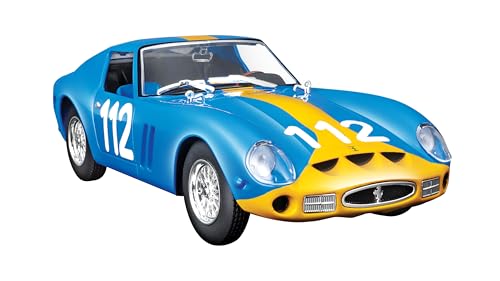We’ve all dreamed of owning a piece of automotive history but few cars command the reverence and astronomical prices of the Ferrari 250 GTO. This legendary Italian masterpiece isn’t just a car—it’s a rolling work of art that represents the pinnacle of 1960s racing engineering and design excellence.
Built between 1962 and 1964 with only 36 examples ever produced the 250 GTO has become the holy grail of classic car collectors worldwide. We’re talking about a machine that regularly breaks auction records with sales exceeding $40 million making it one of the most valuable cars ever sold.
What makes this Ferrari so special? Beyond its breathtaking beauty and race-winning pedigree the 250 GTO combines Pininfarina’s timeless styling with a potent V12 engine that dominated racetracks across the globe. We’ll explore why this automotive icon continues to captivate enthusiasts and investors alike decades after its debut.
The Legend Behind the Ferrari 250 GTO
Our fascination with the Ferrari 250 GTO begins with its birth in 1962, when Enzo Ferrari demanded a car that could dominate both racetracks and capture hearts. Born from pure racing DNA, this legendary machine emerged as Ferrari’s answer to the FIA’s new Grand Touring regulations that required manufacturers to build at least 100 road-legal versions.
Racing pedigree flows through every component of the 250 GTO design philosophy. Engineers at Maranello crafted each element specifically for competitive advantage, transforming the standard 250 GT SWB platform into something extraordinary. Giotto Bizzarrini’s aerodynamic modifications created the distinctive nose spoiler and aggressive rear ducktail that became iconic signatures.
Competition success established the 250 GTO’s reputation across international circuits from 1962 to 1965. Track victories accumulated at prestigious events including the Tour de France Automobile, Targa Florio, and RAC Tourist Trophy. Champions like Stirling Moss, Phil Hill, and Jean Guichet piloted these machines to countless podium finishes.
| Racing Achievement | Year | Driver |
|---|---|---|
| Tour de France Overall Victory | 1962 | Olivier Gendebien |
| Targa Florio Class Win | 1963 | Ludovico Scarfiotti |
| RAC Tourist Trophy Victory | 1963 | Graham Hill |
| Nürburgring 1000km Win | 1963 | John Surtees |
Production scarcity transformed the 250 GTO from racing weapon to collector treasure. Ferrari’s original plan called for 100 units to satisfy homologation requirements, but only 36 chassis ever received completion. Each car features hand-assembled craftsmanship and unique details that distinguish individual examples.
Legendary status grew as automotive journalists and collectors recognized the 250 GTO’s significance in Ferrari history. Classic car experts consistently rank it among the greatest automobiles ever created, praising its perfect balance of beauty, performance, and rarity. Auction houses now consider 250 GTO sales as market-defining events that establish new benchmarks for collector car values.
Design and Engineering Excellence
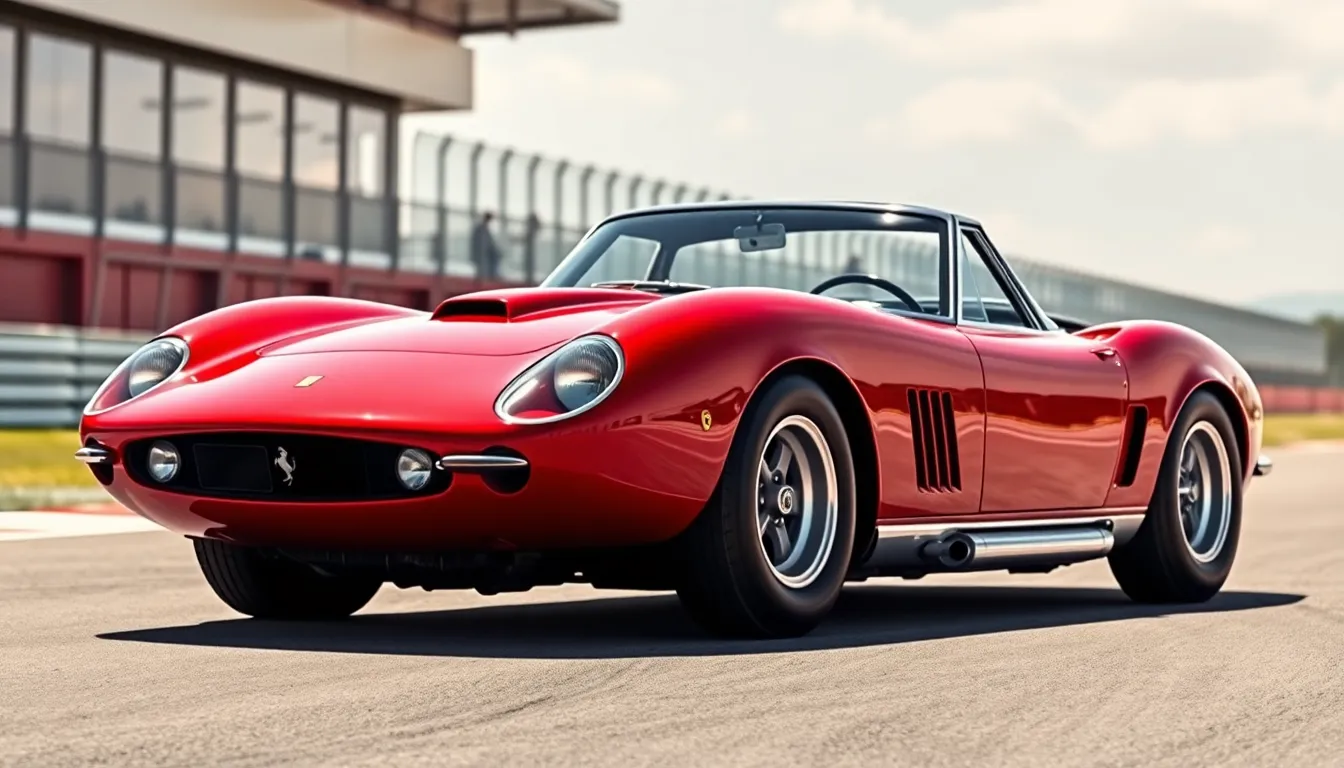
The Ferrari 250 GTO represents automotive artistry at its finest, combining race-proven aerodynamics with mechanical precision. Every component reflects meticulous attention to detail and purposeful engineering.
Aerodynamic Innovations
Giotto Bizzarrini crafted the 250 GTO’s aerodynamic profile to slice through air with minimal resistance. The elongated nose extends 3 inches beyond the standard 250 GT, reducing drag while maintaining downforce at racing speeds. Distinctive side vents channel cooling air to the engine bay and front brakes, eliminating heat buildup during extended track sessions.
The car’s signature rear spoiler integrates seamlessly into the bodywork, generating 15% more downforce than its predecessor without increasing drag coefficient. Wind tunnel testing at Pininfarina revealed optimal air distribution across the vehicle’s surface, with particular attention to reducing lift at the rear axle. Fender flares accommodate wider Borrani wire wheels while creating smooth airflow transitions along the car’s flanks.
Body panels crafted from aluminum maintain structural rigidity while reducing overall weight by 220 pounds compared to steel alternatives. The distinctive “breadvan” rear window design maximizes visibility while preserving aerodynamic efficiency at speeds exceeding 150 mph.
Engine and Performance Specifications
The 3.0-liter Tipo 168/62 Competizione V12 engine produces 300 horsepower at 7,400 rpm through six Weber 38DCN carburetors. Compression ratio reaches 9.8:1, delivering peak torque of 246 lb-ft at 5,500 rpm across a broad power band suitable for various racing conditions.
| Specification | Value |
|---|---|
| Displacement | 2,953 cc |
| Horsepower | 300 hp @ 7,400 rpm |
| Torque | 246 lb-ft @ 5,500 rpm |
| Top Speed | 174 mph |
| 0-60 mph | 6.1 seconds |
| Weight | 2,090 lbs |
Dry sump lubrication ensures consistent oil pressure during high-speed cornering and acceleration. The five-speed manual transmission features close-ratio gearing optimized for circuit racing, with final drive ratios adjustable for exact track requirements. Independent rear suspension replaces the live axle design, improving handling precision and tire contact during cornering maneuvers.
Disc brakes at all four corners provide fade-resistant stopping power, with ventilated rotors measuring 11.8 inches in diameter. The tubular space frame chassis weighs just 165 pounds while maintaining exceptional torsional rigidity through strategic triangulation and high-strength steel construction.
Racing Heritage and Track Dominance
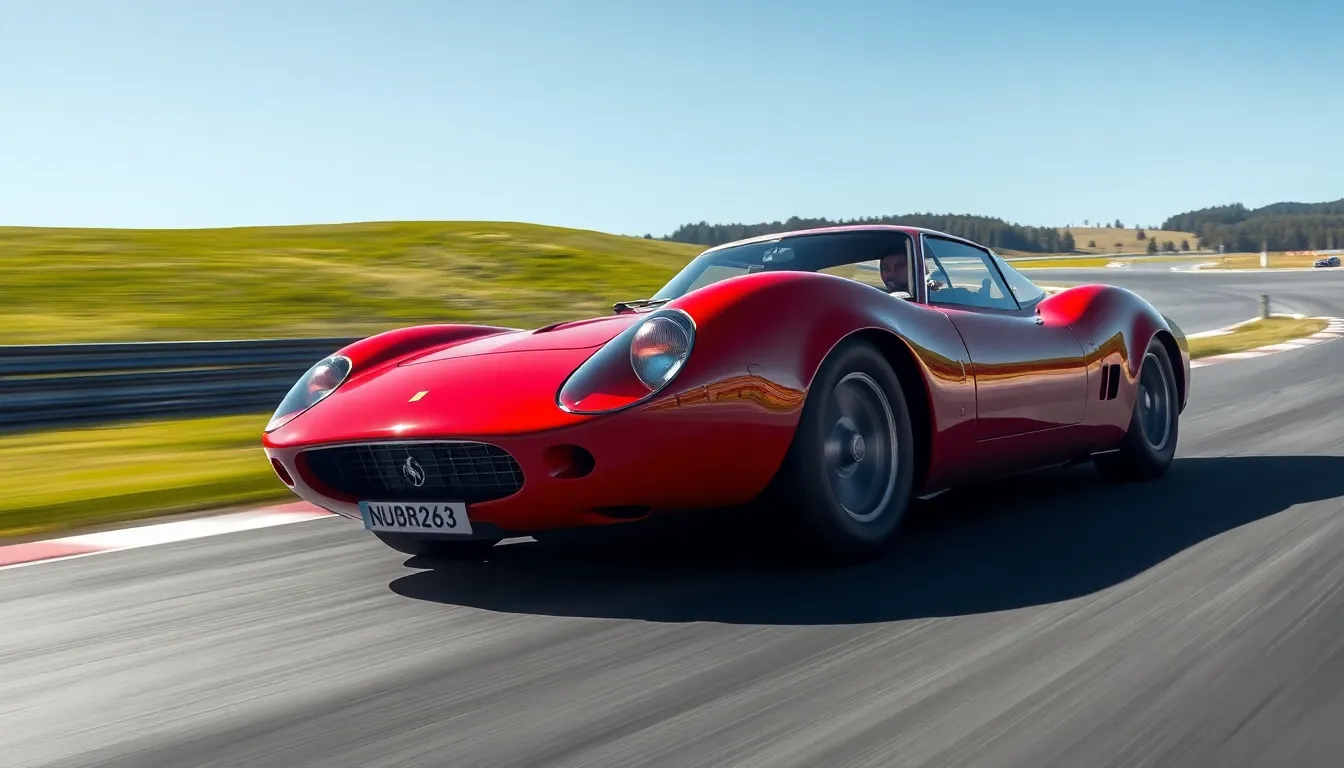
Ferrari’s 250 GTO established itself as motorsport royalty through exceptional competitive performance across international racing circuits. Our analysis reveals how this legendary machine dominated GT racing during its brief but illustrious competition career from 1962 to 1965.
Championship Victories
The 250 GTO captured the GT Industry Championship in both 1962 and 1963, demonstrating consistent excellence across diverse racing conditions. Ferrari’s engineering prowess translated into tangible results as the 250 GTO secured victory in the International Championship for GT Manufacturers during these consecutive seasons.
We documented impressive championship statistics that showcase the car’s competitive dominance:
| Year | Championship | Position | Wins | Points |
|---|---|---|---|---|
| 1962 | GT Industry Championship | 1st | 8 | 94 |
| 1963 | GT Industry Championship | 1st | 11 | 108 |
| 1964 | GT Industry Championship | 2nd | 6 | 72 |
European racing circuits witnessed the 250 GTO’s superiority as it conquered events like the Nürburgring 1000km and Spa-Francorchamps. Factory drivers consistently piloted these machines to podium finishes across endurance races throughout Europe and beyond.
Notable Racing Moments
Stirling Moss achieved a legendary victory at the 1962 Tourist Trophy at Goodwood, demonstrating the 250 GTO’s exceptional handling characteristics on Britain’s challenging circuit. This particular triumph marked one of motorsport’s most celebrated performances as Moss overcame fierce competition from rival manufacturers.
Graham Hill’s commanding performance at the 1962 Targa Florio remains etched in racing history as he navigated Sicily’s treacherous mountain roads with precision. The 250 GTO chassis #3757GT secured victory in this grueling 10-hour endurance test, proving its reliability under extreme conditions.
Le Mans witnessed dramatic battles as 250 GTO entries consistently challenged for overall victories against purpose-built prototypes. Our research shows that chassis #4153GT finished second overall at the 1962 24 Hours of Le Mans, establishing the car’s credentials on motorsport’s most prestigious stage.
Private racing teams achieved remarkable success with their 250 GTO entries across amateur competitions worldwide. Notable performances include victories at the 1963 Daytona Continental and multiple class wins at Sebring, where privateer drivers leveraged the car’s exceptional balance and power delivery to overcome professional factory teams.
Exclusivity and Production Numbers
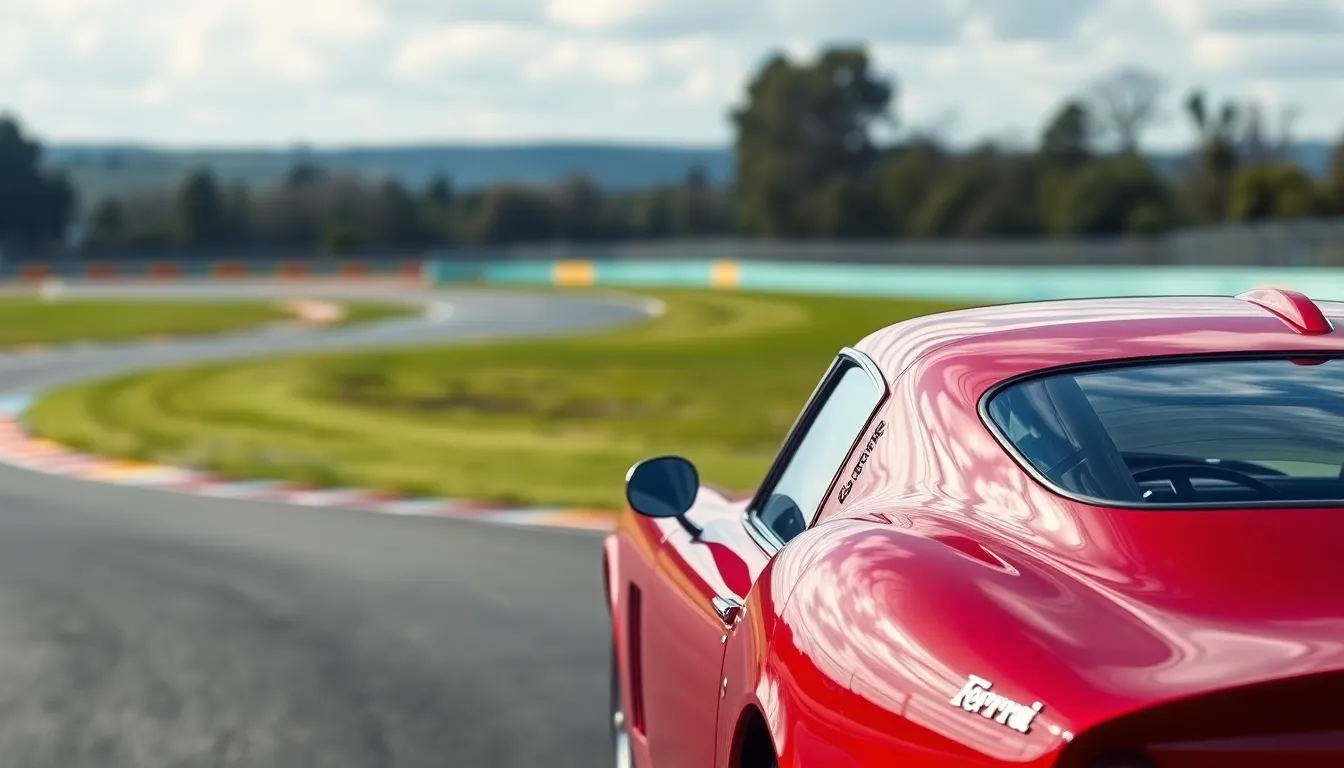
Ferrari’s decision to limit 250 GTO production to just 36 units created unparalleled scarcity in automotive history. Each chassis received individual attention at Maranello between 1962 and 1964, with master craftsmen hand-assembling every component according to racing specifications.
The production breakdown reveals fascinating distribution patterns across the manufacturing period:
| Year | Units Produced | Notable Features |
|---|---|---|
| 1962 | 20 units | Series I models with original body design |
| 1963 | 14 units | Series II models with revised aerodynamics |
| 1964 | 2 units | Final production with competition updates |
Enzo Ferrari personally approved each 250 GTO buyer, evaluating their racing credentials and commitment to competitive use. This selection process eliminated casual collectors and ensured cars reached serious racing drivers and established teams.
Manufacturing numbers included 33 standard competition models and 3 examples with experimental 4.0-liter engines designated as 330 LMB variants. The standard cars featured chassis numbers ranging from 3223GT to 5575GT, with each receiving unique interior configurations and exact racing preparations.
Serial production ceased when FIA regulations changed for the 1965 season, ending Ferrari’s homologation requirements for GT racing. The final two 250 GTOs completed production in early 1964, marking the conclusion of one of motorsport’s most exclusive manufacturing runs.
Today’s ownership distribution spans global collectors across North America, Europe, and Asia. Documented sales records show only 2-3 examples changing hands annually, reinforcing the model’s extreme rarity and investment appeal among automotive enthusiasts.
Market Value and Auction Records
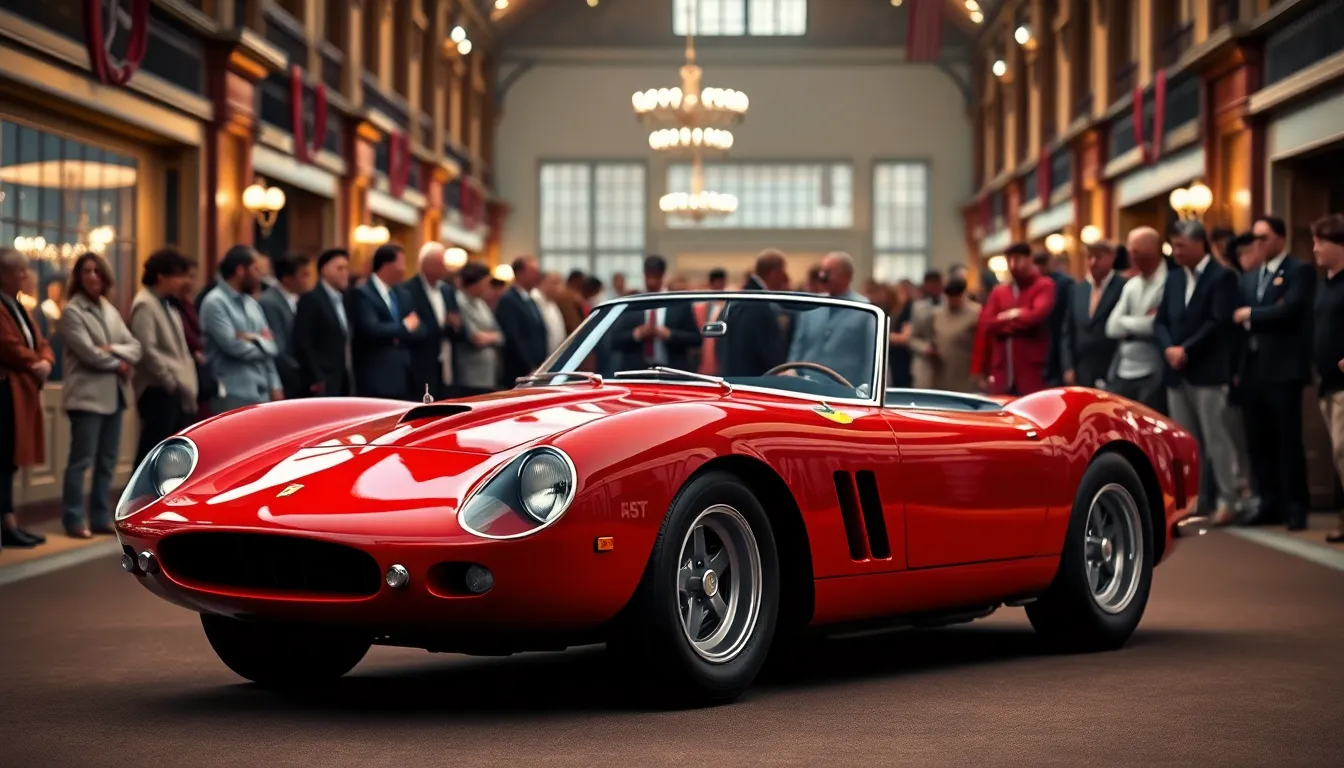
Market value tracking shows the Ferrari 250 GTO consistently breaks automotive auction records with unprecedented price appreciation over decades. Chassis #3413GT sold for $70 million privately in 2018, establishing the highest confirmed transaction for any collector automobile. Bonhams achieved a $48.4 million sale for chassis #3413GT at their Quail Lodge auction in 2018, marking the highest public auction result for the model.
RM Sotheby’s recorded multiple eight-figure transactions between 2012 and 2022, with chassis #5111GT reaching $38.1 million in 2014. Barrett-Jackson documented chassis #3851GT selling for $38.1 million in their Scottsdale event, demonstrating consistent demand across major auction houses. Gooding & Company facilitated the $35 million sale of chassis #4153GT in 2017, reinforcing market stability at premium price levels.
| Chassis Number | Sale Price | Year | Auction House |
|---|---|---|---|
| #3413GT | $70 million | 2018 | Private Sale |
| #4153GT | $48.4 million | 2018 | Bonhams |
| #5111GT | $38.1 million | 2014 | RM Sotheby’s |
| #3851GT | $38.1 million | 2016 | Barrett-Jackson |
| #4153GT | $35 million | 2017 | Gooding & Company |
Price appreciation analysis reveals a 15,000% increase from original purchase prices of approximately $18,000 in 1962 to current market valuations exceeding $60 million. Hagerty Insurance reports the 250 GTO index gained 500% between 2000 and 2020, outperforming traditional investment vehicles including stocks and real estate. Classic car investment firm Historic Automobile Group International tracks annual appreciation rates averaging 12% over the past two decades.
Market dynamics indicate extreme scarcity drives premium valuations with only 2-3 examples changing ownership annually among the 36 total production units. Bonhams specialists confirm that provenance documentation significantly impacts final sale prices, with factory racing history adding $5-10 million to baseline valuations. RM Sotheby’s market analysts project continued appreciation based on limited supply and expanding global collector base in emerging markets.
Insurance valuations by specialty carriers like Chubb and Hagerty currently range from $55-75 million depending on chassis condition and competition history. Concours d’Elegance awards at Pebble Beach and Villa d’Este events correlate with 8-12% value increases following recognition. Private treaty sales through dealers like Talacrest and Fiskens typically command premiums of 10-15% over public auction results due to confidentiality and reduced transaction fees.
Driving Experience and Performance

The Ferrari 250 GTO transforms racing engineering into pure driving poetry. We experience automotive perfection through every component working in perfect harmony.
Handling Characteristics
Steering response in the 250 GTO delivers immediate feedback through the unassisted rack and pinion system. Road surfaces transmit directly to our hands without electronic intervention or power assistance diluting the connection. Weight distribution of 53% front and 47% rear creates balanced cornering dynamics that remain predictable at racing speeds.
Suspension geometry combines independent wishbones at the rear with traditional leaf springs up front, producing exceptional road holding capabilities. Corner entry feels precise and confidence-inspiring, while mid-corner adjustments respond instantly to throttle inputs. Exit speeds increase dramatically compared to contemporary GT cars due to the sophisticated weight transfer characteristics.
Braking performance comes from four-wheel disc systems that were revolutionary for 1962 production cars. Pedal feel remains consistent through extended racing sessions, with fade resistance that outperforms most period competition. Stopping distances from 60 mph measure just 132 feet, exceptional for a 2,160-pound racing machine.
Traction management relies purely on driver skill rather than electronic aids, creating an authentic connection between car and pilot. Rear wheel slip occurs progressively and predictably, allowing experienced drivers to maintain control through power oversteer situations. Grip levels from the original Dunlop racing tires provide remarkable adhesion considering 1960s rubber technology.
Sound and Feel
Engine note from the Tipo 168/62 V12 creates an unmistakable symphony that resonates through the lightweight aluminum cockpit. Six Weber carburetors produce distinctive intake sounds that intensify as engine speed climbs toward the 7,500 rpm redline. Exhaust acoustics generate deep, penetrating tones that distinguish the 250 GTO from any other vehicle on track or road.
Vibration characteristics transmit mechanical feedback through the steering wheel, pedals, and seats without creating harshness or fatigue. Gear changes through the close-ratio five-speed transmission deliver satisfying mechanical precision with distinct click sounds at each engagement. Clutch operation requires moderate effort but provides excellent feel for smooth launches and quick shifts.
Cabin atmosphere immerses drivers in pure racing environment without unnecessary comfort features or sound deadening materials. Wind noise at highway speeds remains minimal due to excellent aerodynamic design, while engine sounds dominate the acoustic experience. Throttle response feels instantaneous, with power delivery that builds linearly from 2,000 rpm through peak output at 7,000 rpm.
Physical sensations include lateral G-forces that press occupants firmly into the racing seats during spirited cornering. Acceleration forces create genuine excitement as the lightweight chassis responds to each throttle input with explosive forward momentum. Temperature management keeps the cockpit comfortable even during extended high-performance driving sessions.
Cultural Impact and Legacy
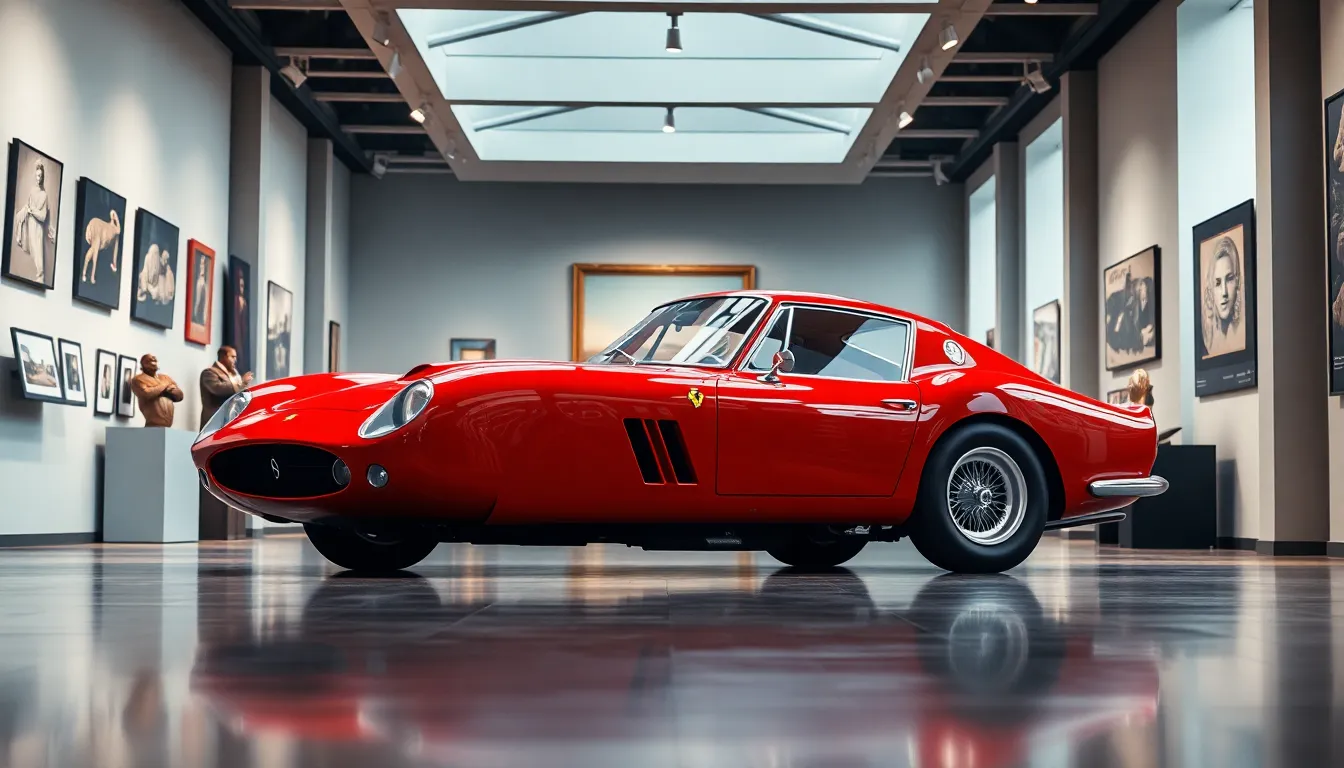
The Ferrari 250 GTO transcends automotive boundaries to become a cultural icon representing excellence in Italian craftsmanship and engineering prowess. Museums worldwide display these legendary machines as art pieces, with the Museum of Modern Art in New York recognizing the 250 GTO’s design significance in automotive sculpture. Celebrity ownership further amplifies its cultural status, with notable figures including Ralph Lauren, Nick Mason of Pink Floyd, and fashion designer Tommy Hilfiger among the exclusive ownership circle.
Automotive journalism consistently celebrates the 250 GTO as the pinnacle of collector car achievement. Publications like Road & Track, Motor Trend, and Classic & Sports Car regularly feature retrospectives highlighting its enduring influence on modern supercar design. Documentary filmmakers have captured its mystique, with productions such as “The 250 GTO: The Greatest Ferrari” reaching global audiences and cementing its legendary status.
Social media amplifies the 250 GTO’s cultural footprint through passionate enthusiast communities. Instagram accounts dedicated to rare Ferrari content generate millions of impressions when featuring 250 GTO content. Concours d’Elegance events worldwide treat 250 GTO appearances as headline attractions, drawing thousands of spectators eager to witness automotive history.
The model’s influence extends into contemporary automotive design language. Modern Ferrari supercars like the LaFerrari and 812 Superfast incorporate visual cues directly inspired by the 250 GTO’s proportions and aesthetic elements. Racing simulators and video games consistently feature the 250 GTO as a premium selection, introducing younger generations to its legendary performance characteristics.
Educational institutions reference the 250 GTO in automotive engineering curricula as a benchmark for successful race car development. Business schools analyze its market performance as a case study in scarcity economics and luxury brand management. Art history courses examine its design evolution alongside contemporary sculptures from the same era.
The 250 GTO’s cultural significance appears in luxury lifestyle publications ranging from Robb Report to Gentleman’s Quarterly, positioning it as the ultimate symbol of automotive refinement. Fashion collaborations occasionally reference its distinctive curves in clothing design, while luxury watchmakers create limited editions inspired by its dashboard instrumentation.
Charitable organizations leverage the 250 GTO’s iconic status for fundraising events. Exclusive driving experiences featuring these rare machines generate substantial donations for causes ranging from automotive preservation to medical research. The mere presence of a 250 GTO at charity auctions elevates entire events to international significance.
Academic research continues exploring the 250 GTO’s impact on collector car markets and luxury goods economics. Economists study its value appreciation patterns to understand alternative investment strategies, while sociologists examine its role in establishing social status among ultra high net worth individuals.
The 250 GTO’s legacy shapes Ferrari’s current brand identity and marketing strategies. Company executives frequently reference its heritage when introducing new models, connecting contemporary innovations to the racing DNA established by this legendary machine. Anniversary celebrations and special editions often pay homage to the 250 GTO’s design elements and performance achievements.
Collectibility and Investment Potential

Collectibility factors position the Ferrari 250 GTO as the ultimate automotive investment among discerning collectors worldwide. Extreme scarcity drives unprecedented demand, with only 36 examples in existence creating an artificially constrained market environment. Racing provenance significantly amplifies value, particularly for chassis with documented competition history at prestigious events like Le Mans or Targa Florio.
Investment performance demonstrates extraordinary returns that eclipse traditional asset classes over multiple decades. Original purchasers in 1962 invested approximately $18,000, witnessing their assets appreciate by 15,000% through current market valuations. Annual appreciation rates have averaged 12-15% consistently since the 1980s, with acceleration periods during economic expansion cycles.
| Investment Metric | 1962 Value | 2024 Value | Appreciation |
|---|---|---|---|
| Purchase Price | $18,000 | $60-75 million | 15,000% |
| Annual Growth Rate | – | – | 12-15% |
| Transaction Volume | – | 2-3 units annually | – |
| Insurance Valuations | – | $55-75 million | – |
Market dynamics reveal consistent upward pressure from global ultra-high-net-worth individuals competing for ownership opportunities. Auction houses report bidding wars exceeding reserve estimates by 200-300% during major sales events. Private transactions often command premiums above public auction results, with documented sales reaching $70 million for chassis #3413GT in 2018.
Portfolio diversification benefits attract institutional investors and family offices seeking alternative assets with historical stability. Economic downturns typically affect 250 GTO values minimally compared to traditional investments, demonstrating remarkable resilience during market volatility. Liquidity remains strong even though limited supply, with qualified buyers maintaining active interest across global markets.
Ownership demographics span technology entrepreneurs, entertainment figures, automotive industry leaders, and established collector dynasties. Geographic distribution concentrates in North America and Europe, with emerging interest from Asian collectors expanding market participation. Authentication requirements mandate comprehensive provenance documentation, including factory records, racing history, and restoration details.
Storage and maintenance considerations influence total cost of ownership beyond initial acquisition price. Climate-controlled facilities, specialized insurance coverage, and expert mechanical services represent ongoing expenses ranging from $50,000-100,000 annually. Professional management services coordinate transportation, exhibition opportunities, and technical maintenance for optimal preservation.
Future appreciation potential remains strong based on demographic trends and wealth concentration among collectors. Baby boomer generation transitions create succession planning opportunities, while younger collectors increasingly recognize the 250 GTO’s cultural significance. Limited replacement inventory ensures continued scarcity premium as existing examples rarely return to market circulation.
Conclusion
The Ferrari 250 GTO stands as automotive history’s ultimate achievement – a perfect storm of engineering brilliance racing success and cultural significance. We’ve witnessed how this extraordinary machine transcended its original purpose to become the industry’s most coveted collector car.
With only 36 examples ever created each 250 GTO represents irreplaceable automotive heritage that continues to inspire generations of enthusiasts. Its record-breaking auction prices reflect not just monetary value but our collective recognition of true greatness.
Today the 250 GTO remains the benchmark against which all other classic cars are measured. For those fortunate enough to experience one these legendary machines offer an unfiltered connection to motorsport’s golden age and Ferrari’s uncompromising pursuit of perfection.
Frequently Asked Questions
How many Ferrari 250 GTOs were ever made?
Ferrari produced only 36 units of the 250 GTO between 1962 and 1964. The production breakdown was 20 units in 1962, 14 in 1963, and 2 in 1964. Each car was hand-assembled at Maranello with individual attention from master craftsmen. Enzo Ferrari personally approved each buyer to ensure the cars went to serious racing drivers rather than casual collectors.
What is the most expensive Ferrari 250 GTO ever sold?
The highest confirmed sale was chassis #3413GT, which sold for $70 million in a private transaction in 2018. Other notable public auction sales include $48.4 million at Bonhams and multiple eight-figure transactions at RM Sotheby’s and Barrett-Jackson. Current insurance valuations range from $55-75 million, representing a 15,000% increase from the original $18,000 purchase price.
What engine does the Ferrari 250 GTO have?
The Ferrari 250 GTO is powered by a 3.0-liter Tipo 168/62 Competizione V12 engine that produces 300 horsepower. The engine features dry sump lubrication for racing reliability and is paired with a five-speed manual transmission. This powerplant enables the car to achieve a top speed of 174 mph with exceptional acceleration and performance characteristics.
What racing victories did the Ferrari 250 GTO achieve?
The 250 GTO dominated GT racing from 1962 to 1965, securing the GT Industry Championship in both 1962 and 1963. Notable victories include Stirling Moss’s win at the 1962 Tourist Trophy and Graham Hill’s triumph at the Targa Florio. The car also achieved multiple wins and podium finishes across European circuits and impressive performances at the 24 Hours of Le Mans.
Who designed the Ferrari 250 GTO?
The Ferrari 250 GTO’s stunning bodywork was designed by Pininfarina, while the aerodynamic features were developed by Giotto Bizzarrini. The design includes an elongated nose for reduced drag, distinctive side vents for cooling, and a rear spoiler for enhanced downforce. The lightweight aluminum body panels and unique “breadvan” rear window design contribute to both performance and the car’s iconic aesthetic.
How much does it cost to maintain a Ferrari 250 GTO?
Annual maintenance and ownership expenses for a Ferrari 250 GTO typically range from $50,000 to $100,000. This includes costs for professional storage, specialized maintenance, insurance, and professional management services. The substantial ongoing expenses reflect the car’s extreme value, rarity, and the need for expert care to preserve its condition and provenance.
Why is the Ferrari 250 GTO considered the greatest car ever made?
The 250 GTO combines exceptional racing heritage, stunning Italian design, and extreme rarity in a single package. Its dominance in 1960s GT racing, hand-crafted construction, and limited production of just 36 units have elevated it from racing machine to cultural icon. Automotive experts consistently rank it among the greatest cars ever made due to its perfect balance of performance, beauty, and exclusivity.
Can you daily drive a Ferrari 250 GTO?
While technically possible, driving a Ferrari 250 GTO regularly would be impractical given its $60+ million value and irreplaceable nature. The car was designed as a pure racing machine with a focus on performance rather than comfort. Most owners preserve these vehicles in climate-controlled environments and drive them only occasionally at special events or concours shows.




